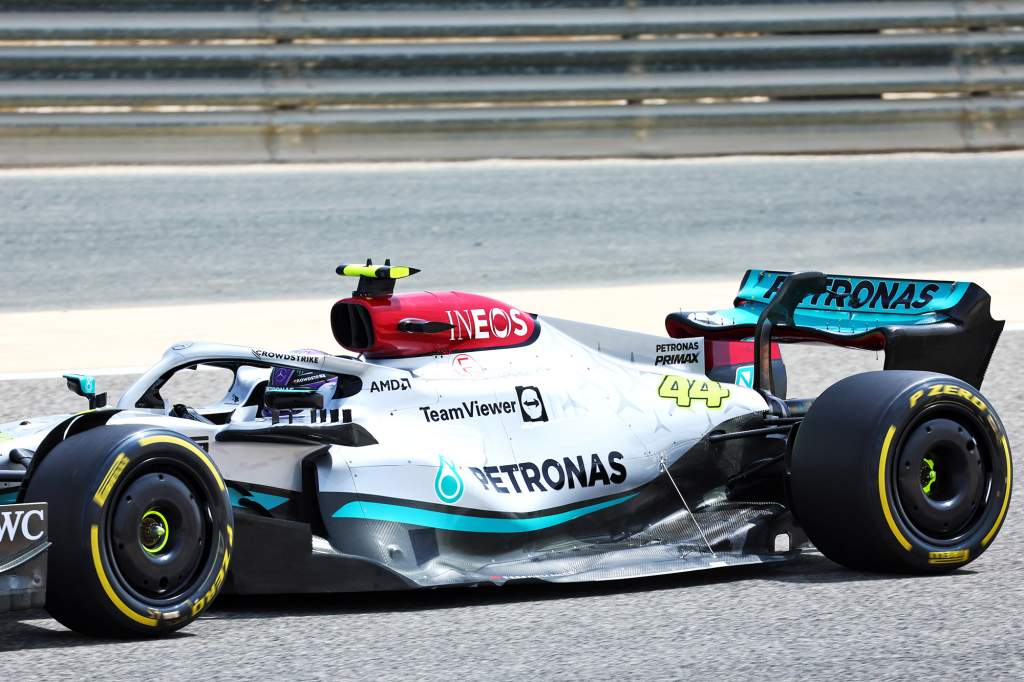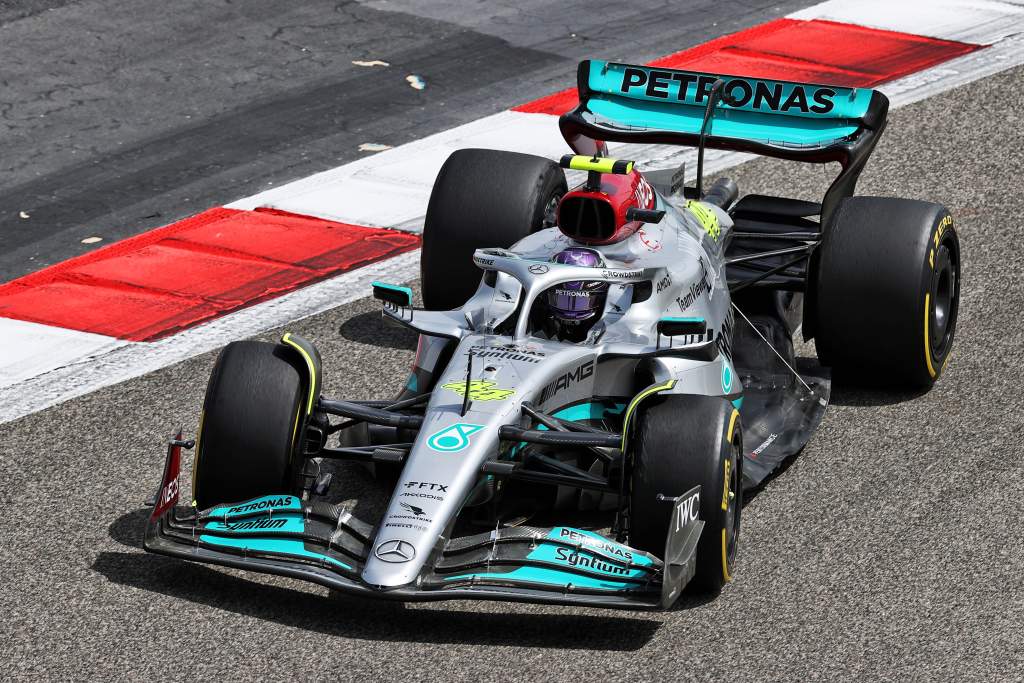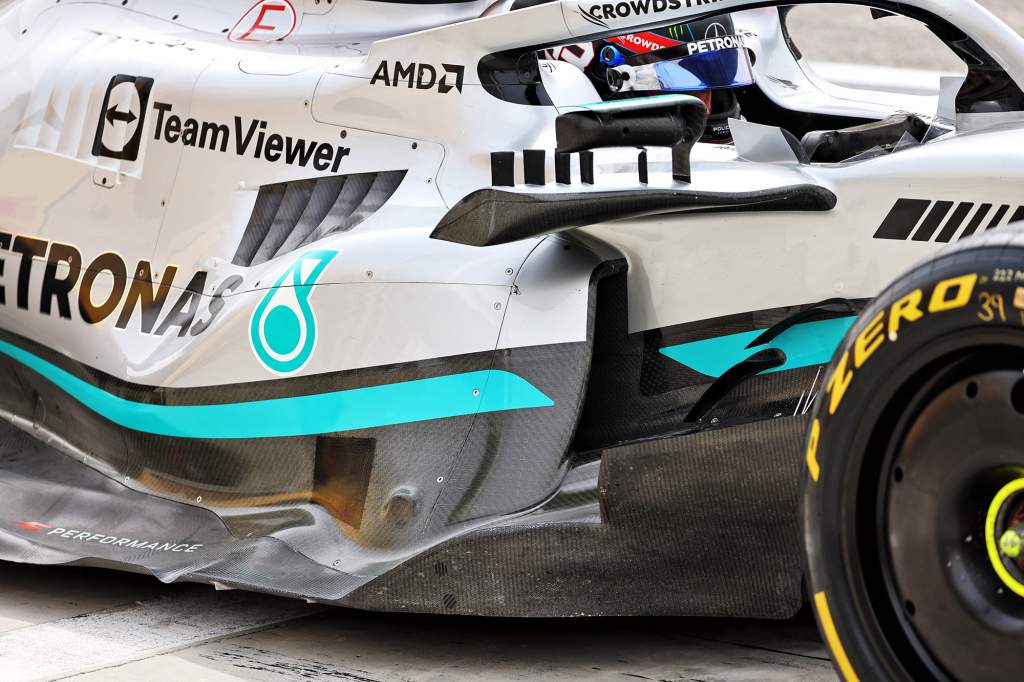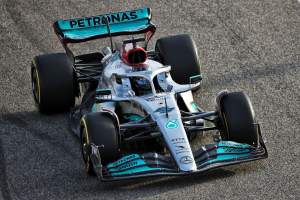Up Next

Discrepancies between the intent of the 2022 Formula 1 technical regulations and the reality of some designs will be discussed at an FIA meeting before the Bahrain Grand Prix.
This is likely to include at least one rival team challenging Mercedes’ innovative design that includes the mounting of the wing mirrors.
Mercedes’ suite of upgrades to its W13 this week include sidepods that have significantly narrowed at the front, while the shroud housing the upper Side Impact Protection system (SIPS) is used as the mounting for the wing mirror and is heavily aero profiled, featuring a series of vanes mounted vertically on the shroud below the mirror.
Red Bull team boss Christian Horner was quoted as suggesting some parts of the W13 went against the spirit of the rules, although Horner and Red Bull later denied having that opinion, while Ferrari questioned the Mercedes mirrors.
Mattia Binotto described the Mercedes design as looking “like spaceships” and suggested that they were primarily an aero part rather than mounting the wing mirror.
“It’s something for the future that needs to be addressed,” said Binotto.
“Already in the past, we said the mirrors should have no aero purpose.
“They should be there just to look behind and I think the way that they [Mercedes] design the cars has a significant aero purpose in the mirrors.”

There is a meeting of the FIA’s technical advisory committee on Tuesday, which will include a discussion over the first “discrepancies” between the rules as written and the cars the teams have designed.
“We always assess rules for following years, and we assess whether things are clear,” said the FIA’s Nikolas Tombazis.
“And when there are new rules, sometimes certain things may not have been phrased as well as we intended and so on.
“By and large, the level of discrepancy is quite low from what was intended. But there are a few little areas and we’ve discussed that with the teams.
“We’ll have another TAC meeting Tuesday to discuss these matters.”
It has been made clear by the rulemakers that swift changes will be pursued if teams come up with designs that are considered undesirable.
But this is primarily regarding the efforts made with the new technical regulations to make the cars follow better.
And while the FIA did not expect some of the solutions produced on the new 2022 cars, Tombazis says has seen nothing that undermines the improved wake characteristics his team hoped to achieve with these rules.
“By and large, I would say there hasn’t been something that we think is contrary to the objectives of the regulations,” he said.

“There’s been some small details perhaps in some areas, which are a bit less less regulated than other areas.
“There have been some winglets and stuff like that which were maybe not fully in line with the objectives but they are relatively small details.”
This could be important because it would in theory rule out any action from the FIA to stop a design such as Mercedes’ mirrors on the grounds of protecting the objectives of the new regulations.
However, the FIA also wants to closely police any loopholes, as it does in any season.
It’s possible the Mercedes mirrors, for example, could be viewed as a design that the rules don’t explicitly outlaw but were not designed to allow.
One argument is that the mirrors should be governed by Article 3.2.2, which states “the aerodynamic influence of any component of the car not considered to be bodywork must be incidental to its main function” and that “any design which aims to maximise such an aerodynamic influence is prohibited”.
Ferrari clearly believes the aero influence of the Mercedes mirror structure goes beyond being merely “incidental to its main function” but Tombazis indicated the Mercedes design does comply with the technical regulations as written for the mirror stay itself.
“The way that is phrased it assigns the name ‘mirror stay’ to bodywork which is declared as such,” said Tombazis.
“In other areas of the car, in other areas of the regulations, we have a statement like ‘for the sole purpose of something, you must do X, Y, Z’.

“And then we take a different view there because it says there the regulations state specifically an objective or reason for existence of a certain component.
“Then if we see a team, obviously doing something different and using that function as an excuse, that we would not allow.
“With the mirror stays, that wording isn’t there.”
AlphaTauri technical director Jody Egginton said the Mercedes bodywork is “interesting” but “good”.
He said there is “nothing really that concerns us at this stage” but believes the Tuesday technical advisory committee meeting will be a mix of short-term clarifications and identifying some items that should be adjusted for 2023.
“There’s two strands really, the things that we want to talk about now to get a clarification or get a bit of an understanding, and then also starting to talk about 2023,” he said.
“Because it’s a good forum to do it and the earlier you start, the better it is.
“So I expect both strands of discussion in the TAC. From our side we’ve got views on a number of topics, some of them insignificant, and some of them just discussion points.
“Every team brings that a table and we start to form a view on what we want to be talking about going forward.
“Both things are on the table for discussion. I’m not going to tell you exactly what’s on the agenda. But it’s both strands.
“I think it will be a fruitful discussion. And we’ll continue that debate. It’s a good technical forum, I’m quite relaxed about it. But there’s plenty to talk about.”






